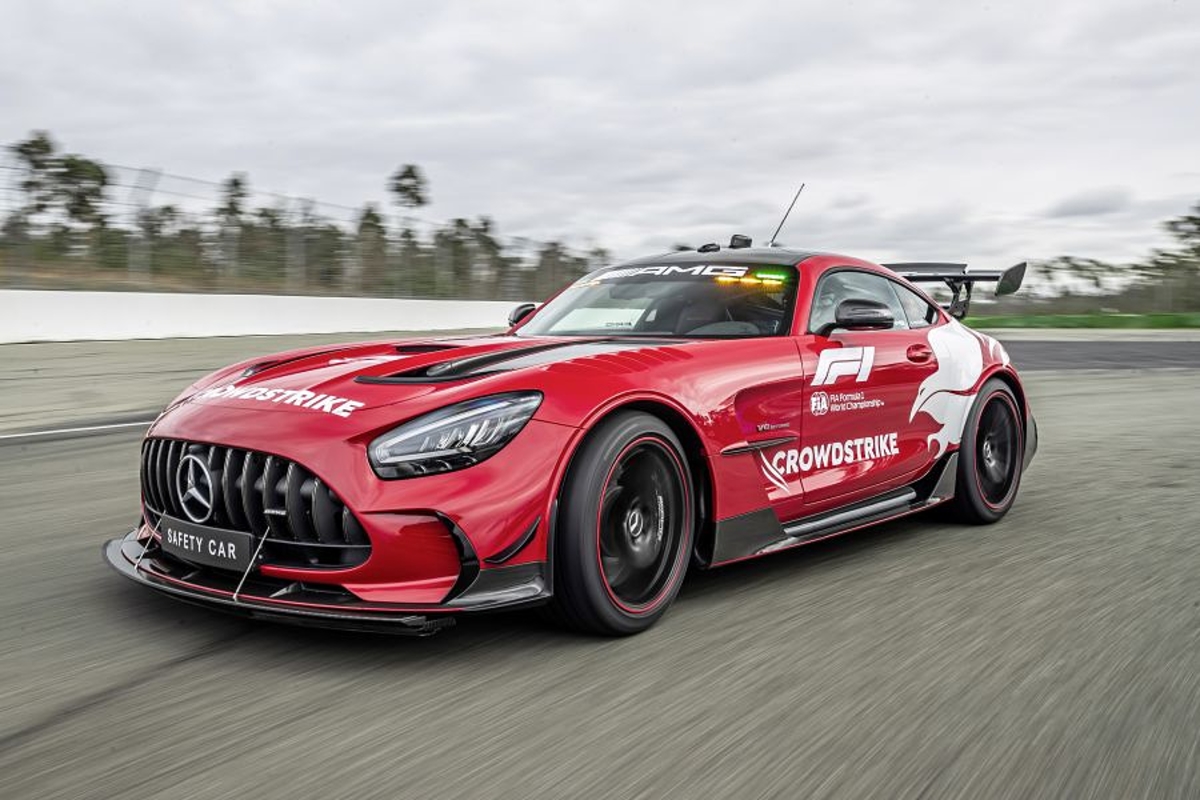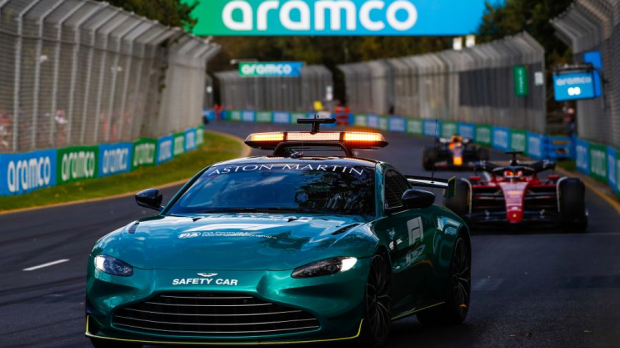
F1 Safety Car explained: Full or virtual, and how it all works
F1 Safety Car explained: Full or virtual, and how it all works

The safety car is one of the two most important cars in the F1 paddock, with the other being the medical car.
As its name suggests, the safety car is a vehicle that is deployed to the track in order to control the field if and when there is a need to bunch up the pack to allow for vital recovery work to be completed.
However, there is the side effect that a compacted field of up to 20 cars will often spark some added on-track excitement, something that can sometimes transform even the dullest of races into a feast for the senses.
Never more was this true than at the 2021 Abu Dhabi Grand Prix, but more on that later.
Rules: What is a safety car, and when is it deployed?
The first instance in which the safety car can be used is during the formation lap in the case of wet weather. This was seen at the controversial 2021 Belgian Grand Prix and last year in Monaco.
To signal this, orange lights are illuminated on the start gantry 10 minutes ahead of the race start time. In these instances, it is mandatory for drivers to fit full wet tyres.
These laps count towards the race distance, given the limited fuel loads carried by the cars.
During a race, the FIA sporting regulations dicate: "The safety car may be brought into operation to neutralise a sprint session or a race upon the order of the clerk of the course.
"It will be used only if competitors or officials are in immediate physical danger on or near the track, but the circumstances are not such as to necessitate suspending (through red flags) the sprint session or the race."
The introduction of the safety car onto the track is signalled through the use of yellow flags and safety car boards; the letters 'SC' are also displayed on the illuminated signs.
When it is safe to do so, the race director will send a message to all teams instructing lapped cars to overtake the field and join the back of the train. The safety car will return to the pits at the end of the lap, which follows this signal being issued.
A following instruction will then be given to inform that the safety car will return to the pits at the end of the current lap, at which point the lights on top of the vehicle will be extinguished as a direct reference to the lead driver.
What is a Virtual Safety Car?
The virtual safety car is different in that it does not bunch the field together. If this system is used, the race director has determined that any recovery work can safely be carried out with drivers lapping at a significantly reduced pace.
This, again, is shown through the use of yellow flags and VSC being shown on the illuminated signs.
Drivers are required to stick to a specific lap delta that is between 30-40 percent off their normal pace.
F1 safety car and pit stops – how it works
At most tracks, a pit stop in normal green flag conditions will see drivers lose between 20-25 seconds to rivals.
But with cars lapping at a significantly reduced pace under either safety car or VSC conditions, this time loss is significantly reduced.
This can advantage or disadvantage any driver and is very much down to luck.
Let's not mention the 2008 Singapore Grand Prix too loudly at this point!
Abu Dhabi 2021: Michael Masi and the most famous safety car of all
We said we'd get back to here!
The confusion and controversy surrounding the 2021 Abu Dhabi Grand Prix were caused by a blurring of the lines between the unofficial 'let them race' principle that had been requested by teams and the regulations.
When Nicholas Latifi crashed on lap 53, Lewis Hamilton led Max Verstappen by 11.9 seconds. At this point, both drivers were on hard tyres.
Verstappen elected to pit to bolt on a set of soft tyres, something that put him behind some traffic but maintained his second position. Hamilton could also have stopped but did not.
At this point, it was not mandatory in the regulations for race director Michael Masi to allow the lapped cars to unlap themselves, meaning that he could restart the race at the drop of a hat.
Mercedes team principal Toto Wolff and Red Bull sporting director Jonathan Wheatley were both on the radio with Masi, arguing their cases, either not for resuming the race or for allowing lapped cars past. In this respect, Wolff has since conceded that this communication went too far.
On lap 57 of 58, Masi then indicated that only the five lapped cars between Hamilton and Verstappen could overtake. Ignoring the requirement to complete an additional lap before returning to green flag conditions, Masi immediately followed this with the announcement that the safety car would return to the pits at the end of that lap.
He later defended this decision, saying that teams had previously agreed that it was desirable for races to end under green flag conditions, referencing the let them race principle.
The last-lap shootout for world title honours was subsequently won by Verstappen, with Mercedes electing not to pursue a lengthy legal procedure despite initially protesting the outcome of the race.
As mentioned, the regulations have been cleared up, and the grey areas that allowed the confusion have been eradicated.
How often does the F1 safety car come out?
There were 25 safety car interruptions and 18 VSCs in the 2022 season.

What model is the F1 safety car?
As was the case in 2022, there are again two safety cars in operation this term, with Mercedes and Aston Martin sharing duties.
Mercedes supplies the $325,000 Mercedes-AMG GT Black Series, while Aston Martin offers the $146,986 Vantage.
Both cars are capable of setting extremely fast lap times by normal standards, but given the other worldly pace of F1 cars, it is not uncommon to hear drivers venting frustrations at the 'slow' speeds.
The Mercedes registers impressive power at 730bhp, a figure that sends it to a top speed of 202mph.
The more modest Aston Martin uses a 4-litre turbo V8 pumps to produce 528 bhp. This gives a top speed of 195mph.
Who drives the F1 safety car?
Bernd Maylander has been the F1 safety car driver since 2000. During his time behind the wheel, he has led over 700 laps in the sport.
The 52-year-old German previously raced in DTM and finished second in his class at the 1999 Le Mans 24 Hours.
READ MORE: What is downforce and why is it important in F1?
Related
Change your timezone:
Latest News

F1 News Today: Newey 'property hunt' reveals Red Bull exit clues as Hamilton hints at Ferrari swoop
- 15 minutes ago

Sky Sports F1 pundit calls for RADICAL change with impressive argument
- 53 minutes ago
- 1

Newey TURNED DOWN F1 rivals before Red Bull decision
- 1 hour ago

Newey's wife 'scoping out properties' in MAJOR hint over next move
- 2 hours ago

Marko reveals how Verstappen has HELPED Perez at Red Bull
- 3 hours ago

Ferrari bound Bearman set to make key F1 move
- Today 12:58
Related news

F1 decision announced regarding points system change

F1 boss HITS BACK at star driver over schedule complaints

F1 franchise welcomes return of INCREDIBLE feature

F1 legend issues DAMNING verdict on proposed rule change
F1 Standings

Drivers
- Oliver Bearman
- Charles Leclerc
- Carlos Sainz
- Lando Norris
- Oscar Piastri
- Pierre Gasly
- Esteban Ocon
- Sergio Pérez
- Max Verstappen
- Alexander Albon
- Logan Sargeant
- Lewis Hamilton
- George Russell
- Nico Hülkenberg
- Kevin Magnussen
- Fernando Alonso
- Lance Stroll
- Valtteri Bottas
- Zhou Guanyu
- Daniel Ricciardo
- Yuki Tsunoda
Races
-
 Gulf Air Grand Prix of Bahrain 2024
Gulf Air Grand Prix of Bahrain 2024
-
 Saudi Arabian Grand Prix 2024
Saudi Arabian Grand Prix 2024
-
 Grand Prix of Australia 2024
Grand Prix of Australia 2024
-
 MSC Cruises Grand Prix of Japan 2024
MSC Cruises Grand Prix of Japan 2024
-
 Grand Prix of China 2024
Grand Prix of China 2024
-
 Miami Grand Prix 2024
Miami Grand Prix 2024
-
 Gran Premio dell'Emilia Romagna 2024
Gran Premio dell'Emilia Romagna 2024
-
 Grand Prix of Monaco 2024
Grand Prix of Monaco 2024
-
 Grand Prix du Canada 2024
Grand Prix du Canada 2024
-
 Gran Premio de España 2024
Gran Premio de España 2024
-
 Grand Prix of Austria 2024
Grand Prix of Austria 2024
-
 Grand Prix of Great Britain 2024
Grand Prix of Great Britain 2024
-
 Grand Prix of Hungary 2024
Grand Prix of Hungary 2024
-
 Grand Prix of Belgium 2024
Grand Prix of Belgium 2024
-
 Heineken Dutch Grand Prix 2024
Heineken Dutch Grand Prix 2024
-
 Grand Prix of Italy 2024
Grand Prix of Italy 2024
-
 Grand Prix of Azerbaijan 2024
Grand Prix of Azerbaijan 2024
-
 Grand Prix of Singapore 2024
Grand Prix of Singapore 2024
-
 Grand Prix of the United States 2024
Grand Prix of the United States 2024
-
 Gran Premio de la Ciudad de Mexico 2024
Gran Premio de la Ciudad de Mexico 2024
-
 Grande Prêmio de São Paulo 2024
Grande Prêmio de São Paulo 2024
-
 Heineken Silver Las Vegas Grand Prix 2024
Heineken Silver Las Vegas Grand Prix 2024
-
 Qatar Grand Prix 2024
Qatar Grand Prix 2024
-
 Grand Prix of Abu Dhabi 2024
Grand Prix of Abu Dhabi 2024
About GPFans
GPFans is a multi-platform, multi-language brand dedicated to Formula One coverage. We bring you all the ins and outs of the sport, 24/7, everything from up-to-the-minute news and features to the latest viral stories and clips.We believe that a new generation of exciting, outspoken drivers will make F1 more popular than ever before, and we want to give our users access to as much of their heroes as possible, on and off the track. From Lewis Hamilton to Max Verstappen, Daniel Ricciardo to Sebastian Vettel, we provide in-depth analysis of every every Grand Prix in the season, from Australia to Abu Dhabi.
With Formula One under the new ownership of Liberty Media, how the sport is being covered is evolving, and GPFans will look to be at the heart of this progression into new media, as one of the fastest-growing sites covering the king of motorsports.
Follow us on your favorite social media channel
Corporate & Media
 Innovatieweg 20C
Innovatieweg 20C7007 CD, Doetinchem, Netherlands
+31645516860



















 Gulf Air Grand Prix of Bahrain 2024
Gulf Air Grand Prix of Bahrain 2024  Saudi Arabian Grand Prix 2024
Saudi Arabian Grand Prix 2024  Grand Prix of Australia 2024
Grand Prix of Australia 2024  MSC Cruises Grand Prix of Japan 2024
MSC Cruises Grand Prix of Japan 2024  Grand Prix of China 2024
Grand Prix of China 2024  Gran Premio dell'Emilia Romagna 2024
Gran Premio dell'Emilia Romagna 2024  Grand Prix of Monaco 2024
Grand Prix of Monaco 2024  Grand Prix du Canada 2024
Grand Prix du Canada 2024  Gran Premio de España 2024
Gran Premio de España 2024  Grand Prix of Austria 2024
Grand Prix of Austria 2024  Grand Prix of Hungary 2024
Grand Prix of Hungary 2024  Grand Prix of Belgium 2024
Grand Prix of Belgium 2024  Grand Prix of Azerbaijan 2024
Grand Prix of Azerbaijan 2024  Grand Prix of Singapore 2024
Grand Prix of Singapore 2024  Gran Premio de la Ciudad de Mexico 2024
Gran Premio de la Ciudad de Mexico 2024  Grande Prêmio de São Paulo 2024
Grande Prêmio de São Paulo 2024  Qatar Grand Prix 2024
Qatar Grand Prix 2024  Grand Prix of Abu Dhabi 2024
Grand Prix of Abu Dhabi 2024